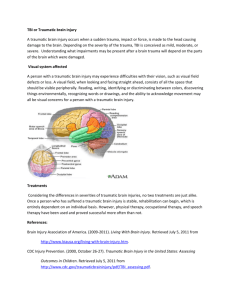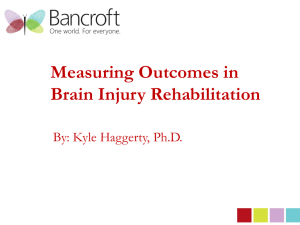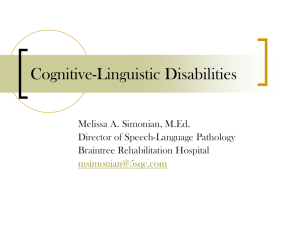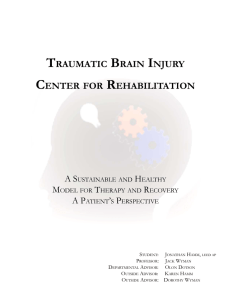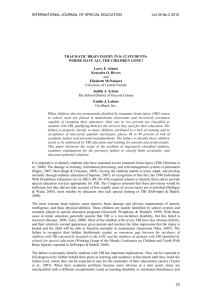CDD 5233 - Kean University
advertisement
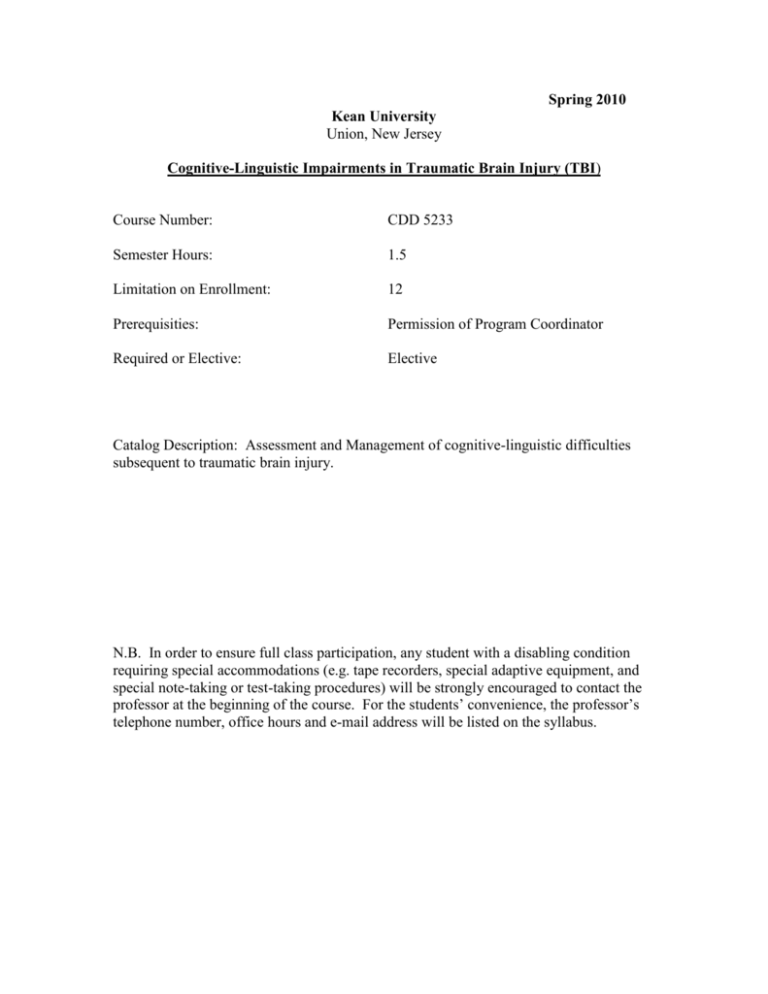
Spring 2010 Kean University Union, New Jersey Cognitive-Linguistic Impairments in Traumatic Brain Injury (TBI) Course Number: CDD 5233 Semester Hours: 1.5 Limitation on Enrollment: 12 Prerequisities: Permission of Program Coordinator Required or Elective: Elective Catalog Description: Assessment and Management of cognitive-linguistic difficulties subsequent to traumatic brain injury. N.B. In order to ensure full class participation, any student with a disabling condition requiring special accommodations (e.g. tape recorders, special adaptive equipment, and special note-taking or test-taking procedures) will be strongly encouraged to contact the professor at the beginning of the course. For the students’ convenience, the professor’s telephone number, office hours and e-mail address will be listed on the syllabus. KEAN UNIVERSITY UNION, NEW JERSEY I. Course Objectives Students will achieve growth toward being informed, dynamic professionals, as evidenced by demonstration of proficiencies in knowledge comprehension, disposition development, and skill application. The student will A. identify and categorize the etiologies of TBI B. correlate various types of TBI with specific patterns of neurophysiologic damage. C. Investigate, compare and contrast involved aspects of cognition D. Differentially diagnose cognitive-linguistic deficits from aphasia, apraxia, and dysarthria E. Select and learn to administer current, appropriate formal and informal tests/methods of assessment of cognitive-linguistic deficits secondary to TBI F. Design intervention programs for clients with cognitive-linguistic impairments subsequent to TBI G. Implement and evaluate strategies for facilitating successful community/school/work re-entry for TBI clients II. Course Content A. Etiologies of TBI 1. Impact to the head-fall, blow 2. Acceleration/deceleration injuries – motor vehicle accidents B. Neurophysiology of TBI 1. Coup Injury 2. Contracoup Injury 3. Shearing Injury 4. Swelling/Bleeding C. Related areas of cognition 1. Speed and Capacity of Information Processing 2. Complex Attention 3. Learning and Memory 4. Executive Functions 5. Awareness D. Cognitive-Linguistic deficits 1. Aspects of cognitive-linguistic impairments, particularly as they relate to TBI 2. Case examples of cognitive-linguistic deficits E. Assessment Procedures 1. Intake Procedures 2. Coma Protocols 3. Language Protocols 4. Observational techniques and checklists 5. Interpretation Results F. Intervention 1. Coma Stimulation Programs 2. Cognitive-linguistic Interventions 3. Therapeutic approaches G. Re-entering community/school/work 1. Strategies 2. Agencies and resources 3. Evaluating success III. Methods of Instruction A. Lecture B. Discussion C. Assigned Readings D. Video/audiotapes E. On-site guided observations of individual and group therapy F. Discussion of observations IV. Methods of Evaluation A. Written examination (K,D) B. Case studies (K,S,D) C. Group cooperative learning projects (K,S,D) V. Required Text Crowe, S. F. (2008). The behavioral and emotional complications of Traumatic Brain Injury. Sussex, GB: Psychology Press. VI. Bibliography Cicerone KD, Dahlberg C, Malec JF, Langenbahn DM, Felicetti T, Kneipp S, Ellmo W, Kalmar K, Giacino JT, Harley JP, Laatsch L, Morse PA, Catanese J. (2005) Evidence-based cognitive rehabilitation: updated review of the literature from 1998 through 2002. Archives of Physical Medicine and Rehabilitation, 8, 16811692. Parrish, C., Roth, C., Roberts, B., Davie, G. (2009). Assessment of CognitiveCommunicative Disorders of Mild Traumatic Brain Injury Sustained in Combat. Neurophysiology and Neurogenic Speech and Language Disorders 19: 47-57 Sohleberg, M.M., Ehlhardt, L., & Kennedy, M. (2005). Instructional techniques in cognitive rehabilitation: A preliminary report. Seminars in Speech and Language. 26, 268-279. Sohleberg, M.M., Kennedy. M.R.T., Avery, J., Coehlo, C., Turskstra, L., Ylvisaker, M., & Yorkston, K. (2007). Evidenced based practice for the use of external aids as a memory rehabilitation technique. Journal of Medical Speech Pathology. 15 (1). Turkstra, L. S., & Bourgeois, M.S. (2005). Intervention for a modern day HM: Errorless learning of practical goals: Journal of Medical Speech Language Pathology. 13(3). 205-212. Turkstra, L. S., Ylvisaker, M., Coehlo, C., Kennedy, M., Sohlberg, M. M., & Avery, J. (2005). Practice guidelines for standardized assessment for persons with traumatic brain injury. Journal of Medical Speech-Language Pathology. 13 (2). Turkstra, L. S., & Kennedy, M. R. T. (2008, July 15). Traumatic brain injury and cognitive rehabilitation. The ASHA Leader, 13(9), 10-13. VII. Seminal Works American Congress of Rehabilitation Medicine Recommendations for use of uniform nomenclature pertinent to patients with severe alterations in consciousness. Archives of Physical Medicine and Rehabilitation, 17, 205-209. (1995). Barco, P.P., Crosson, B., Bolestra, M.M., Werts, D., & Stout, R. (1991) Training awareness and compensations in postacute head injury rehabilitation. In J.S. Kreutzer & P. Wehman (eds.), Cognitive Rehabilitation for person with a traumatic brain injury: A functional approach. Baltimore, MD: Brookes Publishing Company. Cicerone, K.C., Dahlberg, C., Kalmar, K., Langenbahn, D., Malec, J., Berquist, T., Felicitti, T., Giacino, J., Harley, J. P., Harrington, D., Herzog, J., Kneipp, S., Laatsch, L., & Morse, P. (2000). Evidence-based cognitive rehabilitation: Recommendations for clinical practice. Archives of Physical Medicine and Rehabilitation, 81, 1596-1615. Fabiano, R.J., Daugherty, J. (1998). Rehabilitation considerations following mild traumatic brain injury. Journal of Rehabilitation, 64 (4), 9-15. Giacino, J.T. (1997). Disorders of consciousness: Differential diagnosis and neuropathologic features. Seminars in Neurology, 17(2), 105-117. Giacino, J.T., Ashwal, S., Childs, N., Cranford, R., Jennett, B., Katz, D., Kelly, J.P., Rosenberg, J.H., Whyte, J., Zafonte, R.D., & Zasler, N.D. (2002). The minimally conscious state; definition and diagnostic criteria. Neurology, 58, 349-353. Giacino, J.T., & Kalmar, K. (2004). Coma recovery Scale-Revised. Edison, NJ: Johnson Rehabiltation Institution, Solaris Health System. Kay, T. (1986). Minor head injury: An introduction for professionals. Framingham, MA: National Head Injury Foundation, Inc. Levin, H.S., O’Donnell, V.M., & Grossman, R.G. (1979). The Galveston Orientation Amnesia Test: A practical scale to assess cognition after head injury. Journal of Nervous and Mental Disease. 167 (11), 675-684. Mild Traumatic Brain Injury Committee of the Head Injury Interdisciplinary Special Interest Group of the American Congress of Rehabilitation Medicine: Definition of mild traumatic brain injury (1993). Journal of Head Trauma Rehabilitation, 8 (3), 86-87. O’Dell, M.W., Jasin, P., Lyons, N., Stivers, M., & Meszaros, F. (1996). Standardized assessment instruments for minimally responsive, brain injured patients. NeuroRehabilitation, 6, 44-55. VIII. Websites http://www.aan.org http://www.biausa.org http://www.bianj.org http://www.brain-train.com www.cdc.gov/ncipc/pub-res/mtbi/report.htm www.cdc.gov/ncipc/pub-res/tbi_toolkit/physicians/mtbi/mtbi.pdf http://www.tbirecovery.org/

